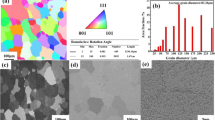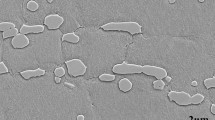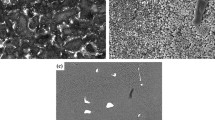Abstract
In this article, the Joule effect heating influence on recrystallization phenomena in the Inconel 718 nickel-based superalloy is investigated in details. On the one hand, static recrystallization kinetic studies at \(1020\,^\circ \mathrm{C}\) after cold deformation up to \(\varepsilon =0.1\) have been performed on a Gleeble 3800 machine, with Joule effect heating, and compared with conventional heating in a radiative furnace, reproducing exactly the same thermal paths in experiments. On the other hand, dynamic recrystallization kinetics have been compared between specimens deformed in the same conditions but varying the heating principle. Compression tests were thus performed on a MTS 250 (radiant heating) and on a Gleeble 3800 (Joule effect heating) at strain rates in the range \(\dot{\varepsilon }\in \left[{10}^{-3}; 1\right]{ \mathrm{s}}^{-1}\) up to a macroscopic strain \(\varepsilon =0.7\) reproducing exactly the same thermomechanical paths. Compression tests were performed at two different nominal temperatures \(T=1050\,^\circ \mathrm{C}\) and \(980\,^\circ \mathrm{C}\) in order to investigate dynamic recrystallization in either δ-phase supersolvus or subsolvus conditions, respectively. As a general trend, Joule effect heating significantly accelerates recrystallization kinetics, and this holds for both static and dynamic recrystallization. Results also suggest that Joule effect heating significantly impacts other metallurgical phenomena like dislocations recovery mechanisms and δ-phase precipitation. The observed differences could not be totally explained by experimental biases resulting from Joule effect heating like radial temperature gradients or differences in initial microstructures. Interactions between electrons and microstructural features such as crystal defects, generally evoked in the literature, are indeed the most probable origin of Joule effect heating impact on microstructural evolutions.























Similar content being viewed by others
References
R.E. Schafrik, D.D. Ward, and J.R. Groh: 5th Int. Symp. Superalloys 718, 625, 706 Var. Deriv., 2001, pp. 1–11.
D. Texier, A.C. Gómez, S. Pierret, J.M. Franchet, T.M. Pollock, P. Villechaise, and J. Cormier: Metall. Trans. A., 2016, vol. 47, pp. 1096–109. .
M. Azarbarmas, M. Aghaie-Khafri, J.M. Cabrera, and J. Calvo: Mater. Sci. Eng. A., 2016, vol. 678, pp. 137–52. .
Y. Wang, W.Z. Shao, L. Zhen, and X.M. Zhang: Mater. Sci. Eng. A., 2008, vol. 486, pp. 321–32. .
M. Zouari, N. Bozzolo, and R.E. Loge: Mater. Sci. Eng. A., 2016, vol. 655, pp. 408–24. .
M. Zouari, R.E. Logé, and N. Bozzolo: Metals., 2017, vol. 7, p. 476. .
R.P. Guest and S. Tin: 6th Int. Symp. Superalloys 718, 625, 706 Var. Deriv., 2005, pp. 373–83.
Y.S. Na, J.T. Yeom, N.K. Park, and J.Y. Lee: J. Mater. Process. Technol., 2003, vol. 141, pp. 337–42. .
D.G. He, Y.C. Lin, M.S. Chen, and L. Li: J. Alloys Compd., 2017, vol. 690, pp. 971–8. .
Y.C. Lin, X.M. Chen, M.S. Chen, Y. Zhou, D.X. Wen, and D.G. He: Appl. Phys. A., 2016, vol. 122, p. 601. .
N. Nayan, N.P. Gurao, S.N. Murty, A.K. Jha, B. Pant, and K.M. George: Mater. Charact., 2015, vol. 110, pp. 236–41. .
Y. Wang, W.Z. Shao, L. Zhen, L. Yang, and X.M. Zhang: Mater. Sci. Eng. A., 2008, vol. 497, pp. 479–86. .
Y.C. Lin, D.G. He, M.S. Chen, X.M. Chen, C.Y. Zhao, X. Ma, and Z.L. Long: Mater. Des., 2016, vol. 97, pp. 13–24. .
S.C. Medeiros, Y.V.R.K. Prasad, W.G. Frazier, and R. Srinivasan: Mater. Sci. Eng. A., 2000, vol. 293, pp. 198–207. .
Y.C. Lin, X.Y. Wu, X.M. Chen, J. Chen, D.X. Wen, J.L. Zhang, and L.T. Li: J. Alloys Compd., 2015, vol. 640, pp. 101–13. .
D. Zhao and P.K. Chaudhury: 3rd Int. Symp. Superalloys 718, 625, 706 Var. Deriv., 1994, pp. 303–13.
N.K. Park, I.S. Kim, Y.S. Na, and J.T. Yeom: J. Mater. Process. Technol., 2001, vol. 111, pp. 98–102. .
L.X. Zhou and T.N. Baker: Mater. Sci. Eng. A., 1994, vol. 177, pp. 1–9. .
D. Jia, W. Sun, D. Xu, L. Yu, X. Xin, W. Zhang, and F. Qi: J. Alloys Compd., 2019, vol. 787, pp. 196–205. .
M. Azarbarmas, M. Aghaie-Khafri, J.M. Cabrera, and J. Calvo: Mater. Des., 2016, vol. 94, pp. 28–38. .
C. Gupta, J.S. Jha, B. Jayabalan, R. Gujrati, A. Alankar, and S. Mishra: Metall. Trans. A., 2019, vol. 50, pp. 4714–31. .
A. Nicolaÿ, G. Fiorucci, J.M. Franchet, J. Cormier, and N. Bozzolo: Acta Mater., 2019, vol. 174, pp. 406–17. .
H. Conrad: Mater. Sci. Eng. A., 2000, vol. 287, pp. 227–37. .
Z.S. Xu and Y.X. Chen: Scripta Metall., 1988, vol. 22, pp. 187–90. .
A.T. Krawczynska, M. Lewandowska, R. Kuziak, and K.J. Kurzydłowski: Phys. Status Solidi C., 2010, vol. 7, pp. 1380–3. .
D. Fabregue, B. Mouawad, and C.R. Hutchinson: Scripta Mater., 2014, vol. 92, pp. 3–6. .
K. Huang, C. Cayron, and R.E. Logé: Mater. Charact., 2017, vol. 129, pp. 121–6. .
Q. Xu, G. Tang, and Y. Jiang: Mater. Sci. Eng. A., 2011, vol. 528, pp. 4431–6. .
W. Bao, X. Chu, S. Lin, and J. Gao: Mater. Sci. Technol., 2017, vol. 33, pp. 836–45. .
E.I. Poliak, S.W. Lee, D.H. Seo, and W.Y. Choo: Met. Mater., 1999, vol. 5, pp. 563–70. .
S.G.R. Brown, J.D. James, and J.A. Spittle: Model. Simul. Mater. Sci. Eng., 1997, vol. 5, p. 539. .
S.D. Norris and I. Wilson: Model. Simul. Mater. Sci. Eng., 1999, vol. 7, p. 297. .
C. Zhang, M. Bellet, M. Bobadilla, H. Shen, and B. Liu: Metall. Trans. A., 2010, vol. 41, pp. 2304–17. .
S.L. Semiatin, D.W. Mahaffey, D.J. Tung, W. Zhang, and O.N. Senkov: Metall. Trans. A., 2017, vol. 48, pp. 1864–79. .
F. Bachmann, R. Hielscher, and H. Schaeben: Ultramicroscopy., 2011, vol. 111, pp. 1720–33. .
A. Seret, C. Moussa, M. Bernacki, R. Signorelli, and N. Bozzolo: J. Appl. Crystallogr., 2019, vol. 52, pp. 548–63. .
A. Nicolaÿ, J.M. Franchet, J. Cormier, H. Mansour, M. De Graef, A. Seret, and N. Bozzolo: J. Microsc., 2019, vol. 273, pp. 135–47. .
V. Beaubois, J. Huez, S. Coste, O. Brucelle, and J. Lacaze: Mater. Sci. Technol., 2004, vol. 20, pp. 1019–26. .
D.G. He, Y.C. Lin, X.Y. Jiang, L.X. Yin, L.H. Wang, and Q. Wu: Mater. Des., 2018, vol. 156, pp. 262–71. .
Y. Wang, W.Z. Shao, L. Zhen, and B.Y. Zhang: Mater. Sci. Eng. A., 2011, vol. 528, pp. 3218–27. .
T.J. Koppenaal and C.R. Simcoe: Trans. Metall. Soc. AIME., 1963, vol. 227, p. 615. .
M.C. Shine and S.R. Herd: Appl. Phys. Lett., 1972, vol. 20, pp. 217–9. .
Y. Onodera and K.I. Hirano: J. Mater. Sci., 1976, vol. 11, pp. 809–16. .
Y. Onodera, J.I. Maruyama, and K.I. Hirano: J. Mater. Sci., 1977, vol. 12, pp. 1109–14. .
Y. Onodera and K.I. Hirano: J. Mater. Sci., 1984, vol. 19, pp. 3935–9. .
W.C. Liu, F.R. Xiao, M. Yao, Z.L. Chen, Z.Q. Jiang, and S.G. Wang: Scripta Mater., 1997, vol. 37, pp. 53–7. .
W.C. Liu, F.R. Xiao, M. Yao, Z.L. Chen, Z.Q. Jiang, and S.G. Wang: Scripta Mater., 1997, vol. 37, pp. 59–64. .
W.C. Liu, F.R. Xiao, M. Yao, H. Yuan, Z.L. Chen, Z.Q. Jiang, S.G. Wang, and W.H. Li: J. Mater. Sci. Lett., 1998, vol. 17, pp. 245–7. .
Y. Mei, Y. Liu, C. Liu, C. Li, L. Yu, Q. Guo, and H. Li: J. Alloys Compd., 2015, vol. 649, pp. 949–60. .
T. Sakai, A. Belyakov, R. Kaibyshev, H. Miura, and J.J. Jonas: Prog. Mater. Sci., 2014, vol. 60, pp. 130–207. .
J. Humphreys, G.S. Rohrer, A. Rollett, J. Humphreys, G.S. Rohrer, and A. Rollett: Recrystallization and Related Annealing Phenomena. 3rd ed. Elsevier, Amsterdam, 2017, pp. 469–508.
R.D. Doherty, D.A. Hughes, F.J. Humphreys, J.J. Jonas, D.J. Jensen, M.E. Kassner, W.E. King, T.R. McNelley, H.J. McQueen, and A.D. Rollett: Mater. Sci. Eng. A., 1997, vol. 238, pp. 219–74. .
K. Huang and R.E. Logé: Mater. Des., 2016, vol. 111, pp. 548–74. .
S.L. Semiatin, D.W. Mahaffey, N.C. Levkulich, and O.N. Senkov: Metall. Trans. A., 2017, vol. 48, pp. 5357–67. .
Acknowledgments
The authors are very grateful for the financial support to this research, received from the French Agency for Scientific Research (ANR) and from the Safran Group via the Industrial Chair ANR-Safran OPALE. RL and MVDM gratefully acknowledge PX Group for their laboratory sponsorship.
Author information
Authors and Affiliations
Corresponding author
Additional information
Publisher's Note
Springer Nature remains neutral with regard to jurisdictional claims in published maps and institutional affiliations.
Manuscript submitted April 1, 2021; accepted July 21, 2021.
Appendix: Modeling of the Radial Temperature Profile in Cylindrical Specimens Heated on Gleeble 3800
Appendix: Modeling of the Radial Temperature Profile in Cylindrical Specimens Heated on Gleeble 3800
In order to evaluate the radial temperature profile \(T(r)\) induced during Joule effect heating of cylindrical specimens on the Gleeble 3800 machine, the system illustrated on Figure 20 (similar to one in Semiatin et al. work[54]) is considered.
The following hypotheses and boundary conditions are considered for the establishment of the temperature evolution along the radius \(T(r)\) expression:
-
2D axisymmetric problem: for a given \(r\) position along the radius, \(T(\theta )=\mathrm{cte}\) with \(\theta \) the angular coordinate in polar coordinates system.
-
The temperature at specimen surface (\(r=a\)) \({T}_{\mathrm{S}}\) is known. For numerical applications, it is taken equal to the one measured on the TC2 thermocouple which is welded at sample half-height (used for temperature regulation).
-
The temperature gradient along the specimen length \(L\) is neglected. In practice, this hypothesis is not strictly verified given that in the context of this work, a deviation of \(\pm 5\,^\circ \mathrm{C}\) between the regulated temperature (TC2) and the temperatures measured at specimen edges (TC1 and TC3) is tolerated. However, this assumption allows to simplify the calculations for a first approximation of \(T(r)\).
The heat equation is given by:
With,
-
\(\rho \): the density
-
\({C}_{\mathrm{p}}\): the specific heat
-
\(\overrightarrow{j}\): the heat flux
-
\(A\): the heat source induced by Joule effect (characterized by the current density \(\overrightarrow{i}\) on Figure 20).
The heat flux \(\overrightarrow{j}\) is given by:
With,
-
\(\lambda \): the thermal conductivity.
Combining Eqs. [A1] and [A2], the heat equation becomes:
In stationary regime, \(\frac{\partial T}{\partial t}=0\), that means for the heat equation that:
By developing the Laplacian \(\Delta T\), Eq. [A4] thus results in:
By noticing that \(\frac{\partial^2 T}{\partial r^2}+\frac{1}{r}\frac{\partial T}{\partial r}=\frac{1}{r}\frac{\partial }{\partial r}\left(r\frac{\partial T}{\partial r}\right)\), Eq. [A5] can also be written as follow:
By integrating Eq. [A6] a first time with respect to \(r\), it becomes:
\(A\) represents the heat source generated by the passage of an alternating current through the sample (Joule effect). When a such kind of current flow through a conductor, this one is subjected to the skin effect. The skin effect is a phenomenon according to which the current tends to flow mainly at conductor periphery over a thickness \(e\). Depending on this thickness \(e\) (so-called skin thickness), the current density \(\overrightarrow{i}\) (and so the source \(A\)) can be heterogeneous along the radius \(r\). For an alternating current frequency \(f\), the skin thickness \(e\) is given by Eq. [A8]:
With,
-
\(\mu \): the magnetic permeability (\(\approx 1.26\times {10}^{-6} \mathrm{H} {\mathrm{m}}^{-1}\) for Inconel 718)
-
\({\rho }_{\mathrm{e}}\): the electrical resistivity (\(\approx 1.25\times {10}^{-6} \mathrm{\Omega m}\) for Inconel 718).
In the case of Gleeble 3800 tests, alternating current frequency \(f\) is \(50 \mathrm{Hz}\). The skin thickness associated with such a current is much higher than the specimen radius \(a=5 \mathrm{mm}\). It is evaluated at \(e=80 \mathrm{mm}\). It can be concluded that the specimens heated on the Gleeble 3800 device are not submitted to the skin effect, and thus, that the current density \(\overrightarrow{i}\) can be considered constant along the radius. Consequently, the source \(A\) can be considered independent of \(r\), and can be taken out of the integral in Eq. [A7] right member, that gives:
That becomes after integration:
Equation [A10] integration with respect to \(r\) and considering the boundary conditions of Figure 20 allows to express \(T(r)\) according to the model parameters:
Source \(A\) corresponds to the electrical power \(P\) dissipated by Joule effect per volume unit. For an alternating current effective intensity \({I}_{\mathrm{eff}}\), it is expressed by:
With,
-
\(V\): the specimen volume
-
\(R\): the specimen electrical resistance \(R=\frac{{\rho }_{\mathrm{e}}L}{\pi {a}^{2}}.\)
Finally, the temperature profile along the radius \(T(r)\) is expressed as a function of the model parameters, material characteristics, and characteristics of the applied electric current by:
Rights and permissions
About this article
Cite this article
Nicolaÿ, A., Franchet, J.M., Cormier, J. et al. Influence of Joule Effect Heating on Recrystallization Phenomena in Inconel 718. Metall Mater Trans A 52, 4572–4596 (2021). https://doi.org/10.1007/s11661-021-06411-5
Received:
Accepted:
Published:
Issue Date:
DOI: https://doi.org/10.1007/s11661-021-06411-5




